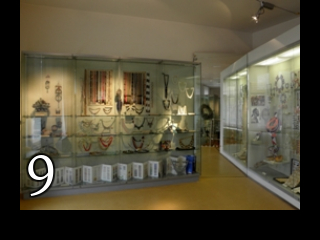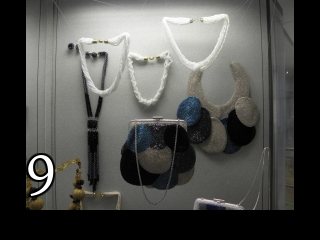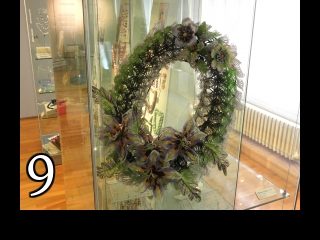Museum of Glass and Jewellery in Jablonec nad Nisou




Tiny glass beads
Transcript
Tiny glass beads may be defined as tiny round or cylindrical elements with a central hole. Their length is approximately the same as their diameter. They are used in costume jewellery and in accessories. Individual types of tiny beads are made with various technologies and they also look different. At first they were chiselled from tubes with a knife, since the 1830s with a specially adapted grinder, locally called “klemprda“. After 1887 manual chiselling was replaced by the incomparably faster machine chiselling. The most important group of chiselled beads are tiny metallurgical beads called rocaille - these are given a surface finish, then doubles (ground twice), triples (ground three times), longer cones - somewhat bulkier cylinders, and other types. A special kind of chiselled bead using for making stitch-ons are extremely tiny beads, often with a diameter of less than 0.8 mm. These beads are also used for embroidered handbags. For export the tiny beads were usually threaded, in groups of fifty, on yarn ten to twenty centimetres long. Twelve such threads formed a loop, two loops formed a bundle. This created a basic unit of one hundred dozen tiny beads, i.e. 1,200 beads. The handbag and collar embroidered with tiny beads were made for our museum in 1974 by the costume jewellery designer Jarmila Hlavová. It’s a variation of items awarded at the international fair Jablonec '74. In 1948, Mrs. Hlavová founded a studio in Prague that made fashion accessories, handbags and braid in small series. And for 10 years she was its manager. In 1959, the studio was absorbed by the state enterprise Železnobrodské sklo - Zásada branch, as a production unit. Mrs Hlavová was in charge until the unit was closed in 1990. Her designs won awards not only at national and international fairs in Jablonec nad Nisou, but also at world fairs in Brussels in 1958 and Montreal in 1967. Tiny beads that form various ornaments are highly popular means of communication in Africa, and make up a significant component of tribal and religious rites. Trinkets from tiny beads are great favourites with the South African Zulu tribe. Young Zulu warriors wore headbands woven from tiny beads, wide chokers and fancy waistbands. All these could also be love gifts. The actual ‘love gifts’ called ‘love letters’ (the literal translation reads “a person writes hoping to receive an answer”), are given by women to young men in whom they are interested. The young men greatly appreciate these ‘love letters’ and wear them in public. A large number of love letters improves a young man's social standing. They used to be made more often than not with tiny beads from Jablonec, as these necklaces from the late 19th century were. Tiny glass beads may be found in the most unusual of places - such as inside tombs in cemeteries. Wreaths and flowers for tombs are made from rocaille and the beads are mostly produced in dark colours. In the first third of the 20th century, the chief exporter of cemetery wreaths was the Jablonec-Paris firm Fried Frères. This exhibit dates back to about 1900.
